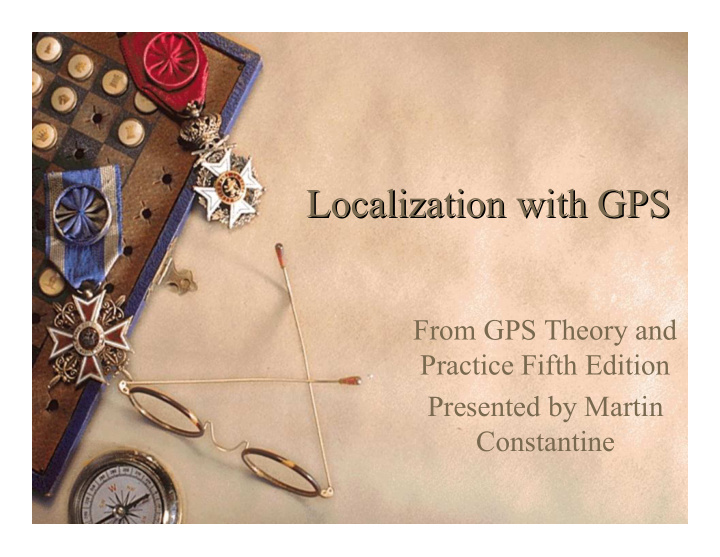



Localization with GPS Localization with GPS From GPS Theory and Practice Fifth Edition Presented by Martin Constantine
Introduction w GPS = Global Positioning System w Three segments: 1. Space (24 satellites) 2. Control (DOD) 3. User (civilian and military receivers)
GPS Overview w Satellites transmit L1 and L2 signals w L1--two pseudorandom noise signals – Protected (P-)code – Course acquisition (C/A) code (most civilian receivers) w L2--P-code only w Anti-spoofing adds noise to the P-code, resulting in Y-code
Observables w Code pseudoranges
Observables w Phase pseudoranges – N = number of cycles between satellite and receiver
Observables w Doppler Data – Dots indicate derivatives wrt time.
Observables w Biases and Noise
Combining Observables w Generally w Linear combinations with integers w Linear combinations with real numbers w Smoothing
Mathematical Models for Positioning w Point positioning w Differential positioning – With code ranges – With phase ranges w Relative positioning – Single differences – Double differences – Triple differences
Point Positioning With Code Ranges With Carrier Phases With Doppler Data
Differential Positioning Two receivers used: •Fixed, A: Determines PRC and RRC •Rover, B: Performs point pos’ning with PRC and RRC from A With Code Ranges
Differential Positioning With Phase Ranges
Relative Positioning Aim is to determine the baseline vector A->B. A is known, B is the reference point Assumptions: A, B are simultaneously observed Single Differences: •two points and one satellite •Phase equation of each point is differenced to yield
Relative Positioning w Double differences – Two points and two satellites – Difference of two single-differences gives
Relative Positioning w Triple-Differences – Difference of double-differences across two epochs
Adjustment of Mathematical Models w Models above need adjusting so that they are in a linear form. w Idea is to linearize the distance metrics which carry the form:
Adjustment of Mathematical Models w Each coordinate is decomposed as follows: Allowing the Taylor series expansion of f
Adjustment of Mathematical Models w Computing the partial derivatives and substituting preliminary equations yields the linear equation:
Linear Models w Point Positioning with Code Ranges – Recall: – Substitution of the linearized term (prev. slide) and rearranging all unknowns to the left, gives:
Linear Models w Point Positioning with Code Ranges w Four unknowns implies the need for four satellites. Let:
Linear Models w Point Positioning with Code Ranges w Assuming satellites numbered from 1 to 4 Superscripts denote satellite numbers, not indices.
Linear Models Point Positioning with Code Ranges •We can now express the model in matrix form as l = Ax where
Linear Models Point Positioning with Carrier Phases •Similarly computed. •Ambiguities in the model raise the number of unknowns from 4 to 8 •Need three epochs to solve the system. It produces 12 equations with 10 unknowns.
Linear Models Point Positioning with Carrier Phases Linear Model
Linear Models Point Positioning with Carrier Phases l = Ax
Linear Models Relative Positioning •Carrier phases considered •Double-differences treated •Recall: DD equation * _ •The second term on the lhs is expanded and linearized as in previous models to yield:
Linear Models Relative Positioning •The second term on the lhs is expanded and linearized as in previous models to yield ( [9.133]…see paper pg 262) • l’ s:
Linear Models Relative Positioning • The right hand side is abbreviated as follows (a’s):
Linear Models Relative Positioning •Since the coordinates of A must be known, the number of unknowns is reduced by three. Now, 4 satellites ( j,k,l,m) and two epochs are needed to solve the system.
Extra References w Introduction and overview: http://www.gpsy.org/gpsinfo/gps-faq.txt
Recommend
More recommend